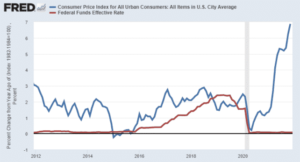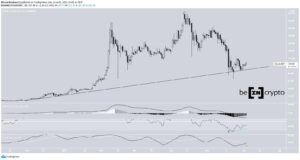
U.S. stocks ended lower Wednesday, extending Tuesday’s losses, after data showed consumer price inflation jumping to the highest in three decades.
The inflation data combined with a poorly received auction of long-dated U.S. government bonds midday didn’t help the market’s complexion either.
How are stock indexes trading?
- The Dow Jones Industrial Average DJIA,
-0.66% fell 240.04 points, or 0.7%, to close at 36,079.94. - The S&P 500 SPX,
-0.82% ended with a loss of 38.54 points, or 0.8%, at 4,646.71. - The Nasdaq Composite Index COMP,
-1.66% finished at 15,622.71, down 263.83 points, or 1.7%.
On Tuesday, the Dow fell 112 points, or 0.3%, after back-to-back gains, while the S&P 500 snapped an eight-day winning streak and the Nasdaq Composite ended a run of 11 consecutive gains.
What’s driving the market?
The Nasdaq Composite led the way lower for major indexes, suffering its worst one-day slump since Oct. 4, as a the 10-year Treasury note yield TMUBMUSD10Y,
The decline in stocks and the sale of 30-year government debt that some analysts described as “disastrous,” comes after inflation data revived concerns that the resulting rise in borrowing costs may upend the current bull run for stocks.
The consumer-price index rose 0.9% in October, compared with economists’ expectations for a rise of 0.6%. The core reading, which excludes volatile food and energy prices, rose 0.6% versus expectations for a 0.4% rise. Year over year, CPI rose 6.2%, a nearly 31-year high and more than triple the Federal Reserve’s 2% target.
“If inflation doesn’t subside, the Federal Reserve may need to taper at a more substantial rate and hike interest rates, which could hurt stocks and bonds,” said Nancy Davis, founder of Quadratic Capital Management and portfolio manager of the Quadratic Interest Rate Volatility and Inflation Hedge Exchange-Traded Fund.
Separately, data showed first-time applications for unemployment benefits fell by 4,000, to 267,000, in the week ended Nov. 6.
Still, equities are trading not far off all-time highs. The S&P 500 and Nasdaq logged the latest in a series of record closes on Monday, while the Dow finished at a record on Friday. The S&P 500 is up nearly 24% in the year to date, while the Dow has risen nealry 18% and the Nasdaq 21%.
The immediate reaction to the data by equity investors makes sense, but doesn’t indicate that they’re convinced inflation that is in large part the product of strong demand and supply-chain bottlenecks will pose a significant danger to earnings, said Art Hogan, chief market strategist at B Riley-National, in a phone interview.
Overall, the data was running hotter than investors would like to see, but they don’t appear convinced that having more demand than supply will be a problem, he said, or that the Federal Reserve is going to speed up its tapering process or move to give up its patient stance on rate increases.
The CPI update comes a day after data showed a further climb for U.S. producer prices. Meanwhile, China on Tuesday reported its own factory gate prices surged 13.5% in October, the highest since 1996. Consumer prices in the country rose 1.5% to a 13-month high, driven mainly by a jump in prices for food and fuel.
“The October CPI report released today makes ugly reading for the Fed and risk-takers with a further broadening of excess inflation pressure highlighted in median and trimmed mean measures as well as a bounce in autos and energy,” wrote analysts at Evercore ISI, Krishna Guha, Peter Williams, and Tobin Marcus, in a Wednesday research note.
Stocks already were under selling pressure early Wednesday but tipped decidedly lower, following a poorly received auction of $25 billion in supply, which was described by Jefferies economists Thomas Simons and Aneta Markowska as one of the worst since 2011, by one measure.
Wednesday’s selloff comes after Tuesday’s losses halted the S&P 500 and Nasdaq Composite’s lengthy winning streaks.
Meanwhile, shares of Tesla TSLA,
After surging 42% in October, the electric-car maker’s stock has dropped 12.6% this week.
Amazon.com Inc. AMZN,
Rivian IPO: 5 things to know about the Amazon-backed electric-vehicle maker
And: NIO forecast disappoints as Chinese electric-car maker faces supply-chain concerns
What companies are in focus?
- Coinbase Global Inc. COIN,
-8.06% stock fell more than 8% after the cryptocurrency platform reported disappointing sales amid a summer slowdown in crypto trading. - DoorDash Inc. DASH,
+11.58% stock climbed 11.6%, after the delivery company posted record sales and orders, and announced an all-stock deal valued at more than $8 billion for Finnish commerce-delivery platform Wolt. - Upstart Holdings Inc. UPST,
-18.21% reported better-than-expected earnings for its latest quarter, but shares fell more than 18%. - Perrigo Co. PRGO,
-11.01% stock fell 11% after disappointing earnings and a profit warning from the Dublin-based consumer self-care products maker, which said it saw record unshipped orders due to supply chain issues.
How are other assets trading?
- The ICE U.S. Dollar Index DXY,
+0.97% , a measure of the currency against a basket of six major rivals, rose 1%. - The U.S. benchmark crude contract CL00,
+0.25% fell $2.81, or 3.3%, to end at $81.34 a barrel. Gold futures GC00,+0.12% settled at their highest since June, up $17.50, or 1%, to at $1,848.30 an ounce. - The Stoxx Europe 600 SXXP,
+0.22% ended 0.2% higher, while London’s FTSE 100 UKX,+0.91% rose 0.9%. - The Shanghai Composite SHCOMP,
-0.41% fell 0.4% and Hong Kong’s Hang Seng Index HSI,+0.74% rose 0.7%, while Japan’s Nikkei 225 NIK,-0.61% fell 0.6%.
Barbara Kollmeyer contributed to this article.
- "
- 000
- 11
- 2020
- 9
- applications
- Art
- article
- Assets
- Auction
- automotive
- Biggest
- Billion
- Bonds
- Borrowing
- Bull Run
- capital
- ceo
- chief
- China
- chinese
- Companies
- company
- consumer
- contract
- contributed
- Costs
- crypto
- crypto trading
- cryptocurrency
- Currency
- Current
- data
- day
- Debt
- delivery
- Demand
- Dollar
- dow
- Dow Jones
- driven
- driving
- dropped
- Early
- Earnings
- energy
- equity
- Europe
- faces
- factory
- Fed
- Federal
- federal reserve
- Focus
- follow
- food
- founder
- Friday
- Fuel
- fund
- Futures
- Global
- Gold
- Government
- Headlines
- High
- Highlighted
- HTTPS
- ICE
- ICON
- Inc.
- index
- industrial
- inflation
- initial public offering
- interest
- Interest Rates
- Interview
- Investors
- IPO
- issues
- IT
- jump
- large
- latest
- Led
- major
- Majority
- maker
- management
- March
- Market
- measure
- Monday
- move
- Nasdaq
- offering
- orders
- Other
- platform
- poor
- portfolio
- pressure
- price
- producer
- Product
- Products
- Profit
- public
- Rates
- reaction
- Reading
- report
- research
- Run
- running
- S&P 500
- sale
- sales
- sell
- sense
- Series
- shanghai
- Share
- Shares
- SIX
- speed
- stock
- Stocks
- Stocks and Bonds
- summer
- supply
- supply chain
- Target
- Technology
- Tesla
- Trading
- treasury
- u.s.
- U.S. government
- unemployment
- Update
- valued
- Versus
- Volatility
- week
- weekend
- year
- Yield



